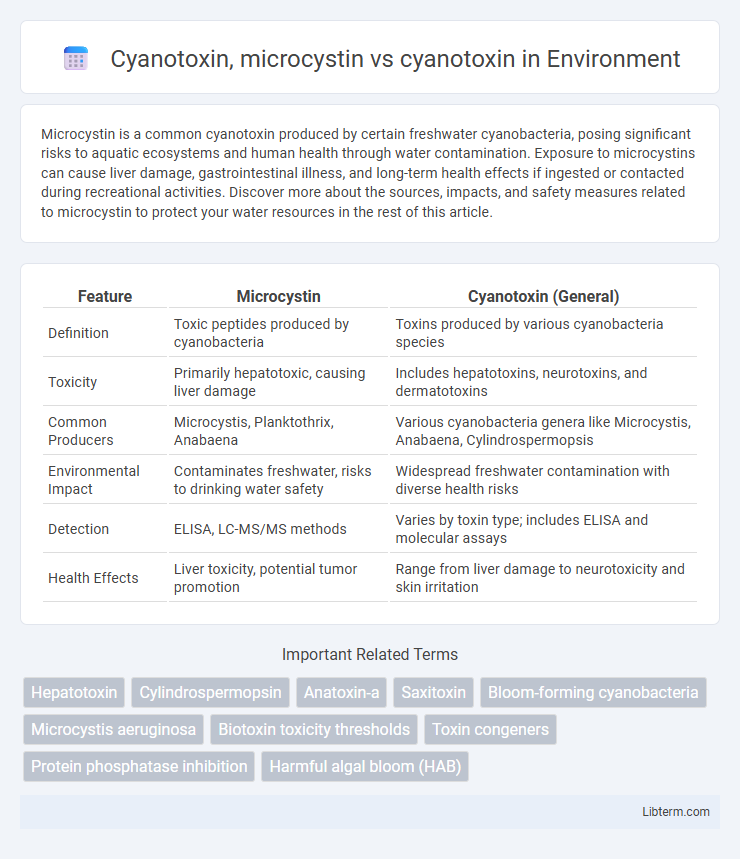Microcystin is a common cyanotoxin produced by certain freshwater cyanobacteria, posing significant risks to aquatic ecosystems and human health through water contamination. Exposure to microcystins can cause liver damage, gastrointestinal illness, and long-term health effects if ingested or contacted during recreational activities. Discover more about the sources, impacts, and safety measures related to microcystin to protect your water resources in the rest of this article.
Table of Comparison
| Feature | Microcystin | Cyanotoxin (General) |
|---|---|---|
| Definition | Toxic peptides produced by cyanobacteria | Toxins produced by various cyanobacteria species |
| Toxicity | Primarily hepatotoxic, causing liver damage | Includes hepatotoxins, neurotoxins, and dermatotoxins |
| Common Producers | Microcystis, Planktothrix, Anabaena | Various cyanobacteria genera like Microcystis, Anabaena, Cylindrospermopsis |
| Environmental Impact | Contaminates freshwater, risks to drinking water safety | Widespread freshwater contamination with diverse health risks |
| Detection | ELISA, LC-MS/MS methods | Varies by toxin type; includes ELISA and molecular assays |
| Health Effects | Liver toxicity, potential tumor promotion | Range from liver damage to neurotoxicity and skin irritation |
Introduction to Cyanotoxins
Cyanotoxins are toxic compounds produced by cyanobacteria during harmful algal blooms, presenting significant risks to aquatic ecosystems and human health. Microcystins represent the most common and studied group of cyanotoxins, characterized by cyclic peptide structures that inhibit protein phosphatases, leading to liver damage upon exposure. Understanding the diversity and biochemical effects of cyanotoxins is critical for water quality monitoring and public health interventions.
What Are Microcystins?
Microcystins are a class of cyanotoxins primarily produced by freshwater cyanobacteria, such as Microcystis aeruginosa. These toxins consist of cyclic heptapeptides that inhibit protein phosphatases, leading to liver damage in humans and animals. Microcystins are among the most studied cyanotoxins due to their toxicity, prevalence in harmful algal blooms, and impact on water safety and public health.
Types of Cyanotoxins and Their Sources
Microcystins are a prominent group of cyanotoxins produced primarily by Microcystis species during harmful algal blooms in freshwater environments. Cyanotoxins encompass various types, including hepatotoxins like microcystins, neurotoxins such as anatoxins, and dermatotoxins like lyngbyatoxins, each synthesized by different cyanobacterial genera like Anabaena, Cylindrospermopsis, and Lyngbya. The presence and concentration of microcystins and other cyanotoxins depend on environmental factors such as nutrient availability, temperature, and light, influencing their distribution in lakes, reservoirs, and drinking water sources.
Chemical Structure: Microcystins vs Other Cyanotoxins
Microcystins are cyclic heptapeptides characterized by the unique Adda (3-amino-9-methoxy-2,6,8-trimethyl-10-phenyl-4,6-decadienoic acid) moiety, which is critical for their hepatotoxic activity. Other cyanotoxins, such as cylindrospermopsin, anatoxin-a, and saxitoxins, exhibit distinct chemical structures: cylindrospermopsin is a tricyclic alkaloid, anatoxin-a is a bicyclic amine, and saxitoxins are tetrahydropurine derivatives. These structural differences influence their specific toxic modes of action, environmental persistence, and detection methods.
Mechanisms of Toxicity: How Do Microcystins and Cyanotoxins Affect Organisms?
Microcystins, a specific group of cyanotoxins produced by cyanobacteria, primarily target the liver by inhibiting protein phosphatases 1 and 2A, leading to hepatocyte disruption and tumor promotion. Other cyanotoxins, such as anatoxins and saxitoxins, affect neural transmission by blocking neurotransmitter receptors or sodium channels, causing neurotoxicity. Both microcystins and various cyanotoxins pose significant ecological and health risks through bioaccumulation and interference with cellular processes in aquatic organisms and humans.
Health Impacts of Microcystins vs Other Cyanotoxins
Microcystins, a class of cyanotoxins produced by cyanobacteria, primarily target the liver, causing hepatotoxic effects that include liver damage, tumor promotion, and acute poisoning in humans and animals. Other cyanotoxins, such as anatoxins and saxitoxins, affect the nervous system, leading to neurotoxicity that can result in respiratory paralysis and neurological symptoms. Chronic exposure to microcystins has been linked to liver cancer and impaired immune function, making them particularly hazardous compared to other cyanotoxins whose acute effects are often more immediate but less chronic.
Detection and Monitoring Methods
Microcystin, a common cyanotoxin produced by cyanobacteria, is typically detected and monitored using advanced liquid chromatography coupled with mass spectrometry (LC-MS) for precise quantification. Immunoassay techniques such as ELISA provide rapid and sensitive screening of cyanotoxins in water samples, enabling early detection and public health protection. Remote sensing technologies and real-time biosensors are increasingly employed for continuous environmental monitoring, offering spatial and temporal data on cyanotoxin presence.
Environmental Occurrence and Risk Assessment
Microcystins, a prevalent group of cyanotoxins produced by cyanobacteria such as Microcystis spp., frequently contaminate freshwater ecosystems experiencing eutrophication and harmful algal blooms. Environmental occurrence of microcystins is often linked to nutrient-rich waters, increased temperature, and stagnant conditions, posing significant risks to aquatic life and human health through water consumption and recreational exposure. Risk assessment emphasizes monitoring microcystin levels using WHO guidelines, highlighting threshold values of 1 ug/L in drinking water to prevent hepatotoxicity and ecological disturbances.
Strategies for Managing Cyanotoxin Contamination
Effective strategies for managing cyanotoxin contamination, particularly microcystins, involve early detection through advanced water monitoring technologies such as ELISA and LC-MS/MS assays, allowing precise quantification of toxin concentrations. Implementing nutrient load reduction, especially controlling phosphorus and nitrogen inputs from agricultural runoff, mitigates cyanobacterial blooms responsible for microcystin production. Water treatment processes including activated carbon filtration, ozonation, and advanced oxidation processes are essential in degrading microcystins to ensure safe drinking water and minimize public health risks.
Conclusion: Addressing the Challenges of Cyanotoxins and Microcystins
Addressing the challenges of cyanotoxins, particularly microcystins, requires enhanced monitoring and advanced water treatment technologies to mitigate their toxic effects on human health and aquatic ecosystems. Strategies must prioritize early detection using molecular and chemical analysis methods to prevent widespread contamination during harmful algal blooms. Integrating regulatory frameworks with public awareness campaigns ensures effective management and reduces the risks associated with microcystin exposure.
Cyanotoxin, microcystin Infographic

 libterm.com
libterm.com